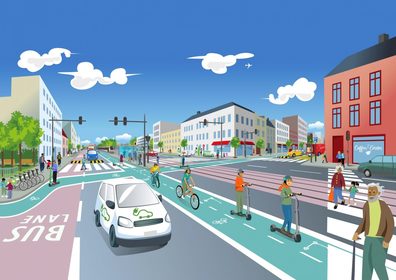Mobility is one of the hottest sectors, with start-ups and traditional OEMs constantly developing new technologies and transportation options. The influx of innovative solutions has yet to solve the problem of congested roads, however, and almost every country is feeling the effects. Drivers in Munich waste an average of 87 hours in traffic every year; in Los Angeles, wasted time in traffic hit 119 hours before the pandemic, when roads were more crowded.
Worldwide, 1.3 billion vehicles are now in use, and many of these are privately owned. There are 868 vehicles per 1,000 capita in the United States, 635 in Norway, and 391 in Mexico. China, by comparison, has only 219 per 1,000 capita, but that still accounts for more than 300 million vehicles on the road. Private vehicles contribute to road congestion because they typically accommodate fewer passengers than public transportation or other shared options. The appeal of private ownership remains strong in many countries despite the recent rise of ride-sharing services. McKinsey analysis shows that private cars are used in 45 percent of all trips, outpacing public transport, micromobility (consisting of scooters and bikes—some electric—and other small vehicles), ride-sharing, ride hailing, and walking (exhibit).
his legacy of private-car congestion does more than frustrate people. It also encourages developers to build garages and public officials to install more parking spaces, gobbling up scarce, valuable urban land that could otherwise be devoted to parks or other amenities. The United States, one of the world’s most car-dependent countries, now has eight available parking spots for every car. Additionally, the expansion of roadways and related infrastructure to ease congestion forces governments to spend more on maintenance and operations. And most critically, the high rates of private-car ownership are contributing to increased carbon emissions.
Within the next decade, however, the mobility ecosystem will most likely undergo a transformation not seen since the early days of the automobile—and one main shift will be the decline of private-car use. Governments are already enacting regulations to reduce the number of vehicles on the road to ease congestion and reduce emissions, and consumers are also voicing preferences for more efficient, green, and convenient transportation options. As technology advances, even more innovative mobility options could emerge, including roboshuttles (shared autonomous minibuses with four to eight seats) or urban air taxis.
The result of all these changes? A mobility ecosystem that is more intelligent, seamless, and environmentally friendly.
Disruptive trends and technologies: The forces transforming mobility
Here’s a look at the disruptive trends and technologies that will shape the future of mobility and the impact that they will have worldwide.
Consumers are excited about the new options
The McKinsey Center for Future Mobility conducts an annual consumer survey that looks at four major trends: autonomous driving, electrification, connectivity, and shared mobility. Many respondents to the 2022 survey say they are open to shifting their transportation habits. Consider a few findings:
- Almost one-third of respondents (30 percent) plan to increase their use of micromobility (for instance, e-bikes and e-scooters) or shared mobility over the next decade.
- Nearly one-half of respondents (46 percent) are open to replacing their private vehicles with other modes of transport in the coming decade.
- Most respondents (70 percent) are willing to use a shared autonomous shuttle with up to three other travelers; 42 percent of those trips would otherwise be taken by private vehicle.
The desire for a more enjoyable mobility experience is behind many of these shifts. A quick trip on the subway while reading a book often beats an hour behind the wheel in traffic, and cities that can offer that convenience might increase metro ridership. Sustainability concerns are also critical. The survey results show that 46 percent of respondents have already switched to more sustainable brands or products, and another 16 percent plan to make considerable changes to promote sustainability.
Regulations are driving awareness and sustainability
In 2020, the transportation sector accounted for about 20 percent of global greenhouse-gas emissions, with more than 40 percent7 of the total coming from private cars. To promote greener transport, over 150 cities have implemented measures to curb private-vehicle use, which include efforts to increase awareness about emissions from private cars, limit the number of private cars in cities, or provide financial incentives to use more environmentally friendly mobility modes.















